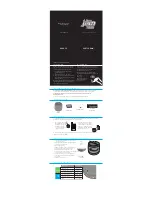
29
ATL™: Advanced Transmission Line. PMC’s unique
bass-loading technology creates more bass from a
cabinet of a given size, while ensuring a consistent
tonal response at all listening levels and a cleaner,
more detailed mid-range. For more information, see:
www.pmc-speakers.com/technology/atl
Bass/Low Frequency/LF: The lowest part of the audible
sound spectrum. Usually considered to range from
approximately 500Hz down to around 20Hz.
Crossover: This essential element of any multi-driver speaker
ensures that the speaker performs optimally, by dividing
the incoming signal from an amplifier into several signals
with frequency ranges best suited to reproduction by each
of the loudspeaker’s drive units. Fenestria’s crossover, for
example, divides the input signal into three (treble, mid-
range and bass) and routes them to the appropriate drivers.
dB (decibel): A logarithmic unit expressing the relative
loudness of a sound. A doubling or halving of audio signal
voltage equates roughly to a 6dB change in output up or
down respectively.
Driver: see Transducer.
Dynamic Range: The range between the quietest and the
loudest sounds a device can produce, usually expressed in
specifications in dB (see above).
Hz (Hertz): Unit of frequency, expressed as the number of
cycles taking place per second.
High-frequency driver: Also known as the Tweeter, HF or
treble driver, this is the smallest of a loudspeaker’s drivers,
designed to handle only the highest frequencies and
tones. Treble drivers usually output frequencies from around
1.8kHz upwards, to beyond the limits of human hearing at
around 18-20kHz.
Laminair™: Aerodynamically optimised vents at the ends of
fenestria’s twin Advanced Transmission Lines. The Laminair™
design eliminates air noise and reduces resistance and air
turbulence, increasing maximum bass output and improving
LF dynamics and timing. For more information, see:
www.pmc-speakers.com/technology/atl-laminair
Low-frequency driver: Also known in loudspeaker circles as
a woofer, LF or bass driver, this is usually the largest driver in
a loudspeaker and handles the lowest tones — generally
from around 500Hz downwards, and sometimes as low as
20Hz.
Mid-range: The frequencies of the audible spectrum to
which the human ear is most sensitive. Usually considered
to range from approximately 500Hz to around 2kHz.
Mid-frequency driver: Also known as the mid-range driver
or simply mid, in a three-way loudspeaker this is the middle
driver. In a two-way loudspeaker, the mid is omitted or
combined with the low-frequency or bass driver. Mid-range
drivers generally handle frequencies from 400Hz to around
3-4kHz.
Nest: In PMC’s fenestria, the solid aluminium central
module which houses the mid- and high-frequency drivers,
and which is mechanically isolated from the rest of the
loudspeaker.
Planar Wings: The side panels of the fenestria speaker, the
planar wings are fitted on compliant mounts, which allows
them to vibrate in polar opposition to the cabinet and act
as tuned mass dampers (see below), eliminating unwanted
vibration.
Stereo Imaging: The sound from a system as it appears
between the speakers of a hi-fi system. Imaging relates to
both width and depth. If imaging is good, it is easy to locate
individual performers and instruments in the reproduced
stereo soundstage.
Transducer: A device that converts energy from one form
to another. A microphone, for example, is a transducer
that converts mechanical vibrations (sound) to electrical
energy. A loudspeaker is a transducer that does the
opposite.
Treble/High Frequency/HF: The highest frequencies in the
audible sound spectrum — broadly speaking, tones like
bells and transient-based percussion. Usually considered
to range from approximately 4kHz to the limit of human
hearing at around 18-20kHz.
Tri-amplification: The practice of connecting three channels
of amplification to a loudspeaker, to power the bass (LF),
mid-range (MF) and treble (HF) drivers independently.
Tri-wiring: The practice of connecting three cables from the
same amplifier to individual bass (LF), mid-range (MF) and
treble (HF) connections. Tri-wiring should not be confused
with tri-amping (see above), in which separate amplifiers
are used for each driver,
Tuned Mass Damper: A large mass added to the top of
skyscrapers as an earthquake-proofing measure. If the
building begins to vibrate due to a seismic disturbance, the
tuned mass damper oscillates in opposition, cancelling out
the destructive seismic resonance. The same principle is
applied to unwanted cabinet resonances in fenestria, with
the planar wings (see above) acting as the tuned mass
dampers.
GLOSSARY OF TERMS
Summary of Contents for Fact Fenestria
Page 1: ...1 userguide...
Page 2: ...2 NOTHING BUT MUSIC...
Page 3: ...3...
Page 4: ...4 www ianwallman com THE SPEAKERS THAT MAKE MUSIC...
Page 6: ...6...
Page 9: ...9...
Page 28: ...28...




































